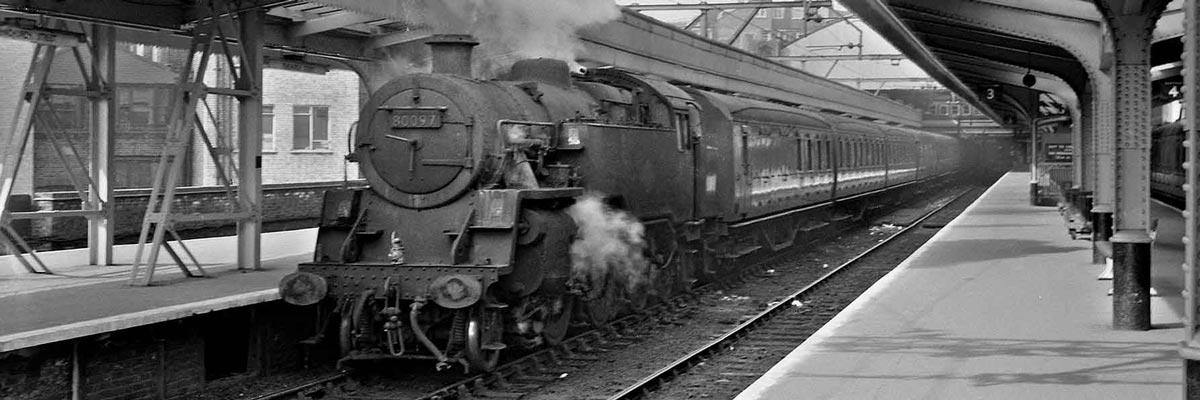Bury Standard 4 Group - Restoring 80097 and 46428
become a supporter, see how you can help learn more...
Browse now and find out more, and support us today.
Your basket is empty
Bury Standard 4 Group - Restoring 80097 and 46428
become a supporter, see how you can help learn more...
Your basket is empty

The British Railways Standard Class 4 tank is a class of steam locomotive, one of the BR standard classes built during the 1950s. They were used primarily on commuter and outer suburban services.
On the nationalisation of British Railways (BR) in 1948 the London Midland Region had a number of ex-London, Midland and Scottish Railway 2-6-4T and the Western Region a number of GWR Large Prairie 2-6-2T types. These tank engines were particularly suited to commuter and secondary services. However, particularly in Scotland and the Southern Region, the situation was not so good with large numbers of pre-grouping types struggling on.
On the decision to build the BR standard series of locomotives, a series of class four tank engines was ordered, based on the ex-LMS Fairburn 2-6-4T with some modifications. The lineage of the class could therefore be tracked through the LMS/BR Class 4 2-6-4T locomotives back to the Fowler design of 1927.
Design work was done at Brighton, the overall programme being overseen by R.A. Riddles. The principal modifications to the Fairburn design involved the reduction of their envelope to enable them to fit into the L1 loading gauge. To do this the tanks and cab were made more curved than the Fairburn design, the Fairburn having a straight-sided tank. The biggest mechanical change was a reduction in cylinder size, also to reduce cross-section, and a corresponding increase in boiler pressure to compensate. Other visible changes include the reintroduction of plating ahead of the cylinders.
130 of the class of 155 were built at Brighton, 15 (80000–80009, 80054–80058) at Derby Works and 10 (80106–80115) at Doncaster Works between 1951 and 1956. The first to emerge was 80010 from Brighton in 1951. Fifteen that were due to be constructed in 1957 were cancelled due to impending dieselisation, and the last five would have been too had they not been at an advanced stage of construction when the order came to cancel them.
No significant modifications were made to the design. The tank vent was found to restrict the driver’s vision and was moved further forward from 80059. Initially built with fluted coupling rods, these caused problems on other classes and from 80079 plain section coupling rods were substituted. The BR standard class 4 4-6-0 was essentially a tender engine derivative of the Standard Class 4 tank.
The Standard 4 tanks were originally allocated to all regions of British Railways, except the Western. They became particularly associated with the London, Tilbury and Southend Line (LT&S) working commuter services out of London until that route was electrified in 1962.
They were also widely used in East Sussex and Kent working from Brighton, Tunbridge Wells and Three Bridges on those lines of the former London Brighton and South Coast Railway that were not electrified. Another group worked from Polmadie depot in the Scottish region on the Glasgow commuter services. Note that from July 1962, a batch displaced by electrification of the LT&S was transferred to the Western Region’s Swansea (East Dock) and Shrewsbury districts, as well as other regions.
In the 1960s there was a mass withdrawal of steam locomotive classes. Older types were withdrawn in preference to the Standard 4s, which class remained intact until 1964. The final nine were withdrawn from the Southern Region on 9 July 1967. One Scottish Region example, 80002, remained in Glasgow past the end of steam haulage until 1969 as a static carriage heating boiler.
No. 80103 was withdrawn in 1962 after being reported for rough riding. It was towed between two other locomotives to Stratford Works, where it was discovered that the mainframe was broken in half. Considered beyond economic repair, 80103 was withdrawn and scrapped. It was the first of the ‘Standard’ locomotives to be withdrawn and the only one scrapped at Stratford.
No fewer than fifteen Standard Four tanks have survived the cutter’s torch. This is the highest number for any preserved BR standard class, and is second only to the now eighteen strong LMS Black Fives as the most preserved main line type, unless the Bulleid Light Pacific’s are counted as one class (there are twenty Light Pacific’s in preservation). Just three of the Standard Four tanks, (80097, 80100 and 80150) have not yet operated in preservation.
The ones listed here have all been restored and have worked in preservation, 80002, 80064, 80072, 80078, 80079, 80080, 80098, 80104, 80105, 80135, 80136 and 80151.